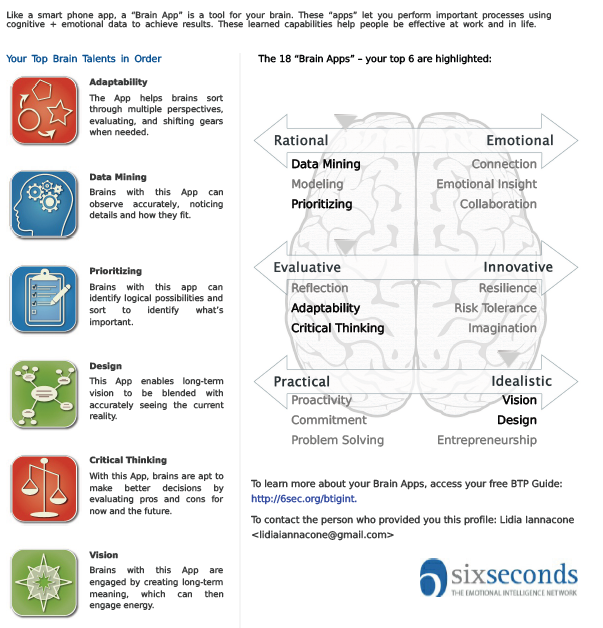“Everybody is a genius. But if you judge a fish by its ability to climb a tree, it will live its whole life believing that it is stupid!”. Each of us has talents and we should pause for a while to realize which they are and leverage them to work at the best of our possibilities.
Emotions drive people, people drive performances, and talents are a key resource to get there! One of the main results of the Amazon workshop (Part I here, Part II here) was the bottom-up definition of an action plan to achieve a business goal to improve the team performance. The whole team was equipped with the Brain Talent Profile (BTP), showing the strengths they have.

Six Seconds defined 18 talents representing the skills owned by the highest performing leaders. The question submitted to thousand of business leaders was “What is a high performing leader doing now (that is effective) that you’d like to see continue?”. Six Seconds collected open text answers as well as questionnaire results, and put in place a semantic analysis, coding thousands of comments to define specific behaviors. Questionnaire scores were used to define a connection between behaviors and emotional intelligence. Then Six Seconds team conducted semantic analyses of the high performers versus the highest performers, asking similar questions to their peers, supervisors and subordinates. In both cases, the most common and “biggest” word is others, i.e. a people-focus.

For high performing leaders, others is associated with effective work, then feelings and needs. For the highest performers, others is associated primarily with caring about people and clients. This is the essence of “people-leadership” — the blend of empathy and performance. Leadership is about people. Top performers go deeper emotionally – not just caring, but personal caring. Not just a good attitude, but giving the energy for people to smile. Best leaders start with caring and create right emotions for success. 62% of comments that distinguish top leaders are emotions driven. Feelings matter.

Six Seconds uses the metaphor of the Brain Apps: each one of us has the potential to download all the desired Apps. Some of them are in the home page (i.e. they are ready to be used in a fast way), others are used with lower frequency and some of them were never downloaded.
Each team member received the brain talent profile which shows the top 6 talents they own the most and they were provided with the details of each talent. BTP is an incredible tool to think about our strengths and to ask ourselves if our behavior is leveraging them. Let’s think about a goal you have. After looking at your talents, some interesting questions could be: (1) Are you using these strengths? (2) What can you do to leverage them as much as possible? (3) Is there any App you should use more (e.g. to be downloaded?) (4) How can you use the strengths to empower the Apps you did not train so far?
I divided the team in smaller groups. Then I asked each one to guess the 6 talents of the other group members. Incredibly, majority of them guessed all the talents and – again – that was the possibility to experience teambuilding and connect with the others, not only as colleagues, but as human beings.
All these workshop activities (including Part I here and Part II here) converged to the last and core part of the workshop: the Team Dashboard.

This is a one-page report, showing the team aggregated data in terms of emotional intelligence score, communication styles, talents (ranked from the first to the last in terms of usage) and performances (ranked from the top to the least in terms of team satisfaction). The manager provided a business goal, linked to one of the EQ areas of performance and the team was asked to define an action plan, based on:
- SWOT of the dashboard, identifying strenghts and derailing factors vs goal, in order to identify 3 main buckets as talents to be sustained, talents to be developed and talents to be moderated
- Individual talents, leveraging on people having strenghts in an area being key to reach the goal
- Managers’ top talents, suggesting specific actions to their leadership by leveraging on their own strenghts
The powerful question to lead the whole exercise was: “What is the dream team? Which are the key talents describing it?”. Actions defined by the team were actionable and assigned to people owning the talent that the team was willing to leverage on!

No responses yet